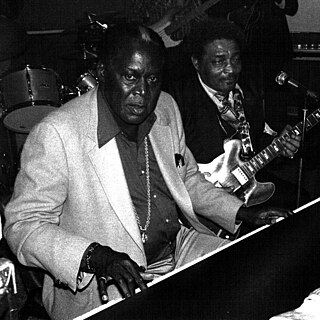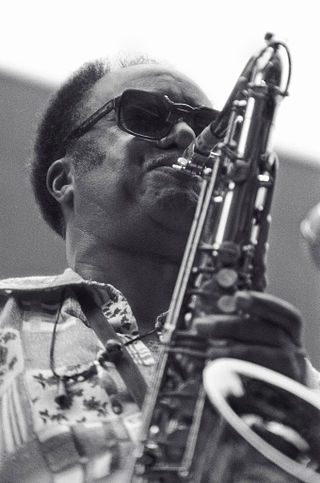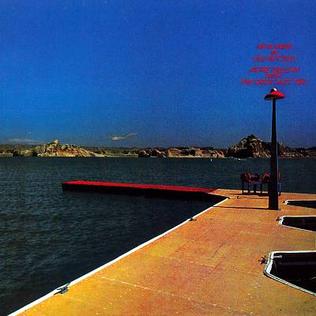Related Research Articles

Anthony Tillmon Williams was an American jazz drummer. Williams first gained fame as a member of Miles Davis' "Second Great Quintet," and later pioneered jazz fusion with Davis' group and his own combo, the Tony Williams Lifetime. In 1970, music critic Robert Christgau described him as "probably the best drummer in the world." Williams was inducted into the Modern Drummer Hall of Fame in 1986.

Ray Charles Robinson was an American singer, songwriter, musician and composer. He is regarded as one of the most iconic and influential musicians in history, and was often referred to by contemporaries as "The Genius". Among friends and fellow musicians he preferred being called "Brother Ray". Charles was blinded during childhood, possibly due to glaucoma.

Maxwell Lemuel Roach was an American jazz drummer and composer. A pioneer of bebop, he worked in many other styles of music, and is generally considered one of the most important drummers in history. He worked with many famous jazz musicians, including Clifford Brown, Coleman Hawkins, Dizzy Gillespie, Charlie Parker, Miles Davis, Duke Ellington, Thelonious Monk, Abbey Lincoln, Dinah Washington, Charles Mingus, Billy Eckstine, Stan Getz, Sonny Rollins, Eric Dolphy, and Booker Little. He also played with his daughter Maxine Roach, a Grammy nominated violist. He was inducted into the DownBeat Hall of Fame in 1980 and the Modern Drummer Hall of Fame in 1992.

Charles Henry Christian was an American swing and jazz guitarist. He was among the first electric guitarists and was a key figure in the development of bebop and cool jazz. He gained national exposure as a member of the Benny Goodman Sextet and Orchestra from August 1939 to June 1941. His single-string technique, combined with amplification, helped bring the guitar out of the rhythm section and into the forefront as a solo instrument. For this, he is often credited with leading to the development of the lead guitar role in musical ensembles and bands.

Julian Edwin "Cannonball" Adderley was an American jazz alto saxophonist of the hard bop era of the 1950s and 1960s.

John Len Chatman, known professionally as Memphis Slim, was an American blues pianist, singer, and composer. He led a series of bands that, reflecting the popular appeal of jump blues, included saxophones, bass, drums, and piano. A song he first cut in 1947, "Every Day I Have the Blues", has become a blues standard, recorded by many other artists. He made over 500 recordings.

Charles Melvin "Cootie" Williams was an American jazz, jump blues, and rhythm and blues trumpeter.

Edmund Leonard Thigpen was an American jazz drummer, best known for his work with the Oscar Peterson trio from 1959 to 1965. Thigpen also performed with the Billy Taylor trio from 1956 to 1959.
James "Osie" Johnson was a jazz drummer, arranger and singer.

Ernest Brooks Wilkins Jr. was an American jazz saxophonist, conductor and arranger who spent several years with Count Basie. He also wrote for Tommy Dorsey, Harry James, and Dizzy Gillespie. He was musical director for albums by Cannonball Adderley, Dinah Washington, Oscar Peterson, and Buddy Rich.
The Alabama Jazz Hall of Fame (AJHF) is an organization and museum in Birmingham, Alabama, United States. It was founded in 1978, and opened as museum on September 18, 1993, with a mission "to foster, encourage, educate, and cultivate a general appreciation of the medium of jazz music as a legitimate, original and distinctive art form indigenous to America. Its mission is also to preserve a continued and sustained program of illuminating the contribution of the State of Alabama through its citizens, environment, demographics and lore, and perpetuating the heritage of jazz music."
Clifton "Skeeter" Best was an American jazz guitarist.

Donald Douglas Lamond Jr. was an American jazz drummer.

The Genius After Hours is an album by American musician Ray Charles, released in 1961. The songs featured on the album were taken from the same three studio sessions that created his 1957 album The Great Ray Charles, which featured the use of both a trio and a septet; the latter was arranged by Quincy Jones. Also appearing on The Genius After Hours is David "Fathead" Newman on tenor and alto saxophone, alongside trumpeter Joseph Bridgewater.

This is a timeline documenting events of Jazz in the year 1985.
Charles Connor was an American drummer, best known as a member of Little Richard's band. Richard's shout of "a-wop bop-a loo-mop, a-lop bam-boom" at the beginning of "Tutti Frutti" is said to be a reference to Connor's drum rhythms. James Brown described Little Richard and his band, with Connor as the drummer, as "the first to put funk into the rhythm."
Milton Turner (1930–1993) was a jazz drummer.

New Wine in Old Bottles is an album by saxophonist Jackie McLean with the Great Jazz Trio; pianist Hank Jones, bassist Ron Carter and drummer Tony Williams, recorded in 1978 for the Japanese East Wind label.
The Big Band and Jazz Hall of Fame is part of a US-based non-profit organization that began operations in 1978 and continues to the present (2022) in San Diego County, California. David Larkin is current president.
The nonprofit West Virginia Music Hall of Fame was established in 2005, to honor the legacies of the state's performing artists in multiple music genres. This hall of fame is the brainchild of its founder, musician Michael Lipton, who was inspired by a visit to the Country Music Hall of Fame and Museum in Nashville, Tennessee. The first exhibit was records from his personal collection.
References
- ↑ "Bill Peeples, 72, 'Gifted Drummer'" Sun-Sentinel . Retrieved 27 June 2013.
- ↑ Palmer, Robert (2009) Blues & Chaos: The Music Writing of Robert Palmer, p.175. Simon and Schuster At Google Books. Retrieved 27 June 2013.
- ↑ "2010 South Florida Jazz Hall of Fame Inductees" The Sunshine Jazz Messenger, Retrieved 27 June 2013.